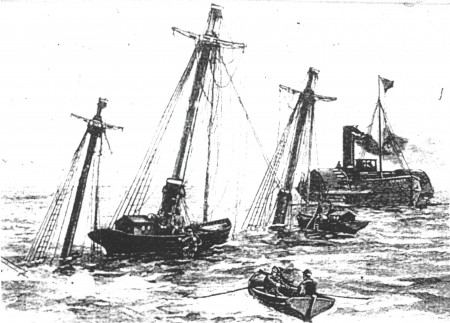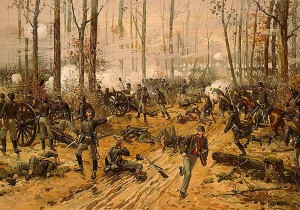TEXAS: Texas Coast Site of First Ship to Ship Battle
President Lincoln had sent Union vessels to block the ports of Galveston, Texas and Sabine Pass, Texas to stop the shipments of goods to Confederate forces in December 1863. On January 1, 1863, Confederate forces engaged Union forces that had taken Galveston and the battle was on. The union Navy would lose several ships and weapons at Galveston and the Confederate forces would regain the island.
On Jan. 8, 8163, the Steamboat Dan which had been captured by Union forces at Lake Charles, La., would be set on fire one mile north of Sabine Pass Lighthouse burning to the waterline. Union forces jumped overboard and the Dan Steamboat sank with a 30 pound Parrot Gun and a 12 pound howitzer on board. Losing the Steamboat Dan required more naval shipping to be sent to protect Sabine Pass.

Photo courtesy of Bruce Lockett USS Morning Light sank Jan. 23, 1863 off the coast Sabine Pass. It was the first ship to ship engagement in East Texas waters.
The Navy sent the USS Morning light and the schooner Velocity , both mast sail, to patrol the area. General McGruder, the new commander of the Army and Navy, sent the vessels Josiah Bell and Uncle Ben to engage the Union forces at Sabine Pass. While at Orange, cotton bales were loaded on the vessels to protect them from cannon and small fire. These vessels were known as Cotton Clad Steamers. One long range cannon was placed on board the Josiah Bell under the direction of the Davis Guard and Lt. Dick Dowling, who later became famous with 47 Irishman at the Battle of Sabine Pass. The Uncle Ben was loaded with two – 12 pound cannon on field carriage and down the river they headed eagerly for the fight with the Union vessels.
When they were spotted by the Union vessels, they pulled anchor and set sail to run. Immediately out of the pass, they engaged the Union vessels. Numerous 32 pound shells were sent towards the Morning Light, striking her. The main mast of the ship in the center was truck and tumbled to the deck. A 32 pound gun was struck, killing one sailor ad injuring nine others. The black smoke was belching from the Confederate vessels as they closed rank. The Union sailors were unable to man their guns because the confederate soldiers kept the deck of the Morning Light alive with bullets like a bee hive.
Captain Dillingham of the Morning Light realized he could not continue the fight. He had no wind as a way of escape and his only recourse was to surrender.
The sister ship, Velocity, found the same fate and when she saw the Morning Light surrender, she was next in line. This was the first ship to ship engagement in east Texas waters. When efforts were made to bring the USS Morning Light across the bar at Sabine Pass it was thought the Morning Light would stick in the mud and block the pass. Efforts were made to strip gun powder and weapons except for the large 32 pound cannons, which each weighed some 7,500 pounds. When Union forces approached the ship, she was set on fire and burned, sinking some 25 feet of water. The capture of the USS Morning Light and USS Velocity were the first ship to ship engagement causing the Union forces to lose nearly 150 men, 11 pieces of artillery and additional supplies taken from the two ships.
In 1863, Confederate forces would capture some 11 ships and more than 50 cannon, which would assist in the continuance of the war. During the Civil War, in 1863, this was the only time war ships were off the Texas coast. Recent evidence of timber washing up on the beach may be remains of the USS Morning Light. Approximately 17 timbers, some over 18 feet long and 12×12 in size, have surfaced on the beach, which show the ship is breaking up. It would be nice to preserve these items for future research and study, but that is another story. They must be processed through Texas Historical Commission for Preservation.
–orangeleader.com
—
MISSISSIPPI: National Park Service Gains More Civil War Sites
CORINTH, Miss. — Dale Wilkerson, superintendent at Shiloh National Military Park, made no claims as an artist as he turned over a press release and started doodling.
 His first sketch was an extremely rough representation of the area where Union and Confederate forces clashed during the Battle of Shiloh on April 6-7, 1862. The site comprises 5.8 square miles of land more or less clumped together, which are now under the protection of the National Park Service.
His first sketch was an extremely rough representation of the area where Union and Confederate forces clashed during the Battle of Shiloh on April 6-7, 1862. The site comprises 5.8 square miles of land more or less clumped together, which are now under the protection of the National Park Service.
Wilkerson’s second sketch was a series of squiggly circles set apart from each other. Though not to scale, the drawings represented 950 acres of important sites during the Battle of Corinth on April 29-May 30, 1862, and the Second Battle of Corinth on Oct. 3-4 that same year.
“At Corinth, it’s little islands,” Wilkerson said. “The authorized areas are spread out.”
In December, the National Park Service took official ownership of 11 new tracts of land. Of the 950 acres authorized by Congress in September 2000, the Corinth Unit of Shiloh National Military Park now controls 800 acres.
There’s more to do, but the acquisitions to date represent a 25-year effort to preserve hallowed ground. Its importance stretches well beyond Corinth and Mississippi.
“This is all in the national interest,” said Rosemary Williams, chairman of the Siege and Battle of Corinth Commission.
In early 1862, Gen. Ulysses Grant captured Fort Henry and Fort Donelson in Tennessee, so he controlled the Tennessee River from Kentucky to Muscle Shoals, Alabama. Wilkerson said the general’s next target was the railroad crossing at Corinth that supplied Confederate troops.
Grant chose Pittsburgh Landing on the Tennessee River to offload his troops and supplies. The ensuing Battle of Shiloh claimed 23,746 casualties, and then Federal troops marched toward Corinth.
“The Battle of Shiloh happened because of the railroad tracks in Corinth,” Wilkerson said. “It’s really all about Corinth.”
Near the end of the 20th century, Shiloh was under the protection of the National Park Service, while the Corinth sites were owned by different people and agencies. Some of the land was pristine, while other parcels had houses built on them. One tract had a school.
In 1991, a five-member commission was appointed by Corinth city officials and Alcorn County officials to do a study of the region’s Civil War legacy.
“They recognized that if it wasn’t preserved it would be lost forever,” Wilkerson said.
About 10 years later, Congress authorized a plan to acquire the properties. Approximately $20 million has been spent on the effort since then.
“Most of it was appropriated by the federal government,” Williams said, “but we also have had support from the state of Mississippi, private foundations and local and private donations.”
The Friends of the Siege and Battle of Corinth is a 501(c)(3) nonprofit organization created to raise money and make purchases. Larry Mangus is the group’s president.
“I usually get a call at least once a month, ‘Would you be interested in buying .?'” he said. “I say, ‘Would you be interested in donating'”
Though there are a few small parcels here and there, most of the 950 designated acres already has been purchased to be included in the Corinth Unit of Shiloh National Military Park.
Legalities are holding up the last 150 or so acres. Before the National Park Service can take control, the title has to be free and clear. Reversion clauses and ownership disputes add levels of difficulty.
“Some of it we may never get resolved, but that’s a small piece of it,” Mangus said.
Members of both the Siege and Battle of Corinth Commission and the Friends of the Siege and Battle of Corinth will keep working toward their ultimate goal.
“We’re not nearly as busy as we once were,” Williams said, “but, to a certain extent, I think we should always be available. This land needs to be preserved. It’s our mission to accomplish that.”
Both Union and Confederate commanders ordered their troops to dig trenches and fill baskets with dirt to provide cover from enemy fire. Men created field fortifications out of soil, timber, bales of cotton and whatever else was handy.
The Corinth Unit includes earthworks built before the first Battle of Corinth, as well as those Federal troops constructed and used when the Rebels tried to retake the city.
“The largest section is going to be to the north, where the Confederate siegeworks are,” Charles Spearman, acting supervising ranger at Corinth, said of the newly acquired property. “It’s between Old 45 and the railroad tracks.”
Mangus called those siegeworks “some of the best I’ve seen.”
Modern people don’t always know what they’re looking at. Battery F in Corinth, which was part of an earlier transfer, also has field fortifications that are easy to identify when three Civil War experts point them out. Without experienced guides, others might just see a series of hills and slopes.
“Unfortunately, we have a problem with people riding golf carts on them,” Wilkerson said, pointing to a warn path at Battery F. “I’ve instructed the maintenance department to put up some trees to block the way.”
Saving the sites also has involved taking down some structures. Mangus sought help from the Corinth Fire Department for a controlled burn of a dilapidated building near the Corinth Civil War Interpretive Center.
“None of them are done with unwilling condemnation,” Wilkerson said. “It’s all done by willing buyers and sellers.”
West Corinth Elementary is gone, too. The Friends purchased it about two years ago, but that’s not why it closed.
“The school was closed during school consolidation,” Spearman said.
It presents an interesting bureaucratic problem, because the old playground and the other parts of the property were included in the original 950-acre boundary, but the school itself was not.
Should Wilkerson use his limited discretion to add it?
What if another, more deserving piece of land becomes available?
Or should he ask for another act of Congress to expand the Corinth Unit?
The ongoing legal questions might be frustrating at times, but they’re tiny concerns when compared to the 250,000 men who battled over the course of six to eight months in 1862 and incurred 40,000 casualties.
“That’s how many men and lives that railroad cost,” Wilkerson said.
Thanks to more than 25 years of effort by a variety of people, those formerly contested “islands” of Civil War history will be saved for future generations.
“The purpose of trying to figure out how to get the land to the National Park Service is that’s how it will be saved,” Wilkerson said. “This land has the same protection as Yellowstone National Park, the same as Yosemite. You’ve got a lot of historically significant land. How do you protect it in perpetuity? You give it to the National Park Service.”


